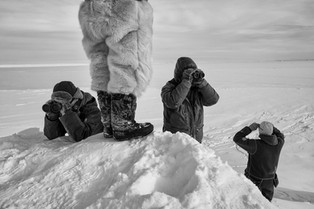LEICA Q- the extreme test
- Carsten Egevang
- Dec 1, 2017
- 3 min read
Updated: Jun 13, 2020

I’ve been photographing in Greenland with the Leica Q for two years now. The focus of my photography is the traditional living of the Inuit of Greenland, like the use of the sled dog. On my trips to both east, west and north Greenland I have used the Q as my “second camera”. In the extreme low temperatures of the Arctic it is a challenge to keep the batteries warm. The Leica Q is perfect because of the small size, and I can keep it warm under my suit, ready to shoot when something interesting appears. Furthermore, the sealing of the Leica Q is excellent and have gone the distance under the most difficult conditions.
See images shot with the Leica Q here:
In Greenland, climate change is now!
For two years, award-winning Danish photographer Carsten Egevang brought the Leica Q (typ 116) on one of his many trips to Greenland. For more than a decade Egevang has been documenting traditional Greenland lifestyle and wildlife. But things are changing in Greenland. Climate change is rapidly altering the living conditions for both man and animals.
Outside the Arctic, global climate change is addressed through abstract mathematical models and prophecies of conditions in some distant future. In Greenland, it is different! Here, climate change is real, present and happening at a rapid pace. The residents both humans and animals, are experiencing fundamental changes in the surrounding environment on a daily basis.
Today, I’m combining photography with my scientific background and my long field experience. I travel to Greenland with my camera to shoot wildlife and to document the traditional Inuit way of life as it unfolds in modern Greenland.
I feel a strong urge – almost an obligation – to communicate my fantastic Greenland experiences to a broad audience. The natural beauty of Greenland is unmatched in the World but the environment of the Arctic is also extremely vulnerable.
The traditional way of life in Greenland is being threatened today. Each passing season witnesses the period with sea ice becoming shorter. This is affecting the migration routes of the animals and the opportunities of transportation for the local peoples. I feel it is urgent for me as a photographer to document the strong hunting traditions of Greenland before it is too late. That is why I keep coming back year after year with my camera.
In few other places in the world is the connection and dependency between people, animals the surrounding environment as strong as in Greenland. Here, life is on the edge of what is physically possible! Only species that are adapted to the extreme climate can survive here. Only the people who can decode nature's signs and predict the weather can find food in this arctic desert.
When I started my photography in Greenland my fascination, as with so many others, was directed towards the beauty of the country. I wanted to photograph the colors of the Greenlandic landscape, icebergs, northern lights and the arctic animals. If humans or anything man-made, such as a house, appeared in my pictures I would discard them.
Today my approach has changed radically! My mission is now to document how the indigenous people of today still rely on the surrounding nature. I strive to place humans and animals in a larger context. I seek to display animals and humans as but a small element in the breathtaking Greenland landscapes. I seek to capture the interactions between the people and the animals which are essential to human survival – both culturally as well as in the household. This is achieved not by a single, short trip to the Arctic on a cruise ship but requires spending long periods of time in Greenland. It requires following the hunters on their dog sleds, snow mobiles and small dinghies when they venture out on their quests for food.
In my opinion, there is no better way to communicate this than through B/W photography!
About Carsten Egevang:
I originally trained as a biologist, completing a PhD in Arctic biology at the University of Copenhagen. Today, I work primarily work with photography – and almost exclusively in Greenland. I lived in Nuuk, the capital of Greenland, from 2002 - 2008, and, although I now live in Copenhagen, Denmark I maintain a strong connection to Greenland, where I visit at least three times a year.
I have been recognized in several international photo competitions, including category winner in the BBC Wildlife Photographer of the Year - the highest position a Dane has yet been awarded in this prestigious competition. I have also been awarded the title of "Danish Nature Photographer” (2011) and am a proud recipient of the Greenland Government’s "Environment and Nature Prize" (2012). I'm also a core member of the Arctic Arts Project (((http://arcticartsproject.com/)))- a collaborative of the most celebrated and talented environmental photographers of our day, communicating the effect of climate change in the Arctic.
















































Comments